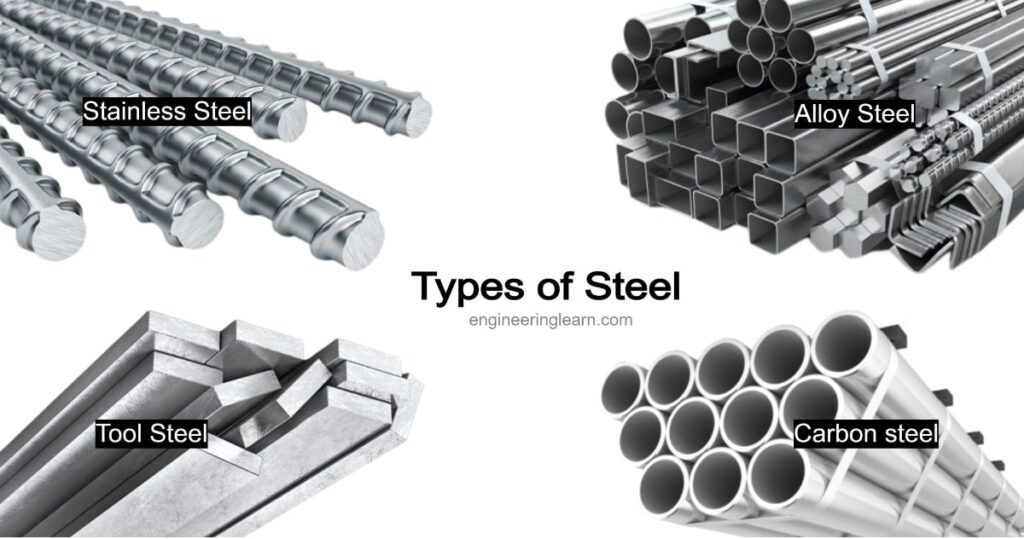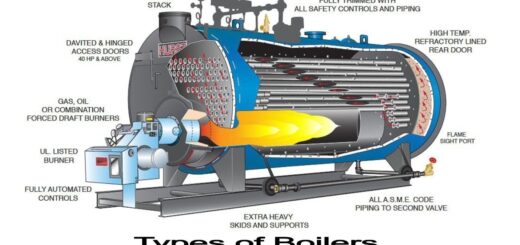Types of Steel and Their Uses [Complete Guide]

Types of Steel and Their Uses :- There are mainly four types of steel: ( Types of Metals )
4 Different Types of Steel
- Stainless steel
- Carbon steel
- Alloy steel
- Tool steel
1. Stainless Steel: ( Types of Steel )
Stainless steel is very popular among all types of steels. It is shiny in appearance and has 10 percent to 20 percent of chromium as alloy. Using chromium as alloy prevents the steel from being corroded and enables it to mould easily into various shapes. Due to its ductility and flexibility stainless steel is best suited for silverware, home applications, surgical equipment etc.
Stainless steel is of four different types:
a) Ferritic
Ferritic is the stainless steel in which chromium percentage lies in between 10. 5 percent to 30 percent. This type of steel does not have carbon content more than 0. 1%. It is magnetic in nature and has high resistance against temperature oxidation as well as stress corrosion cracking.
b) Austenitic
Austenitic is a very common type of stainless steel and it contains high nickel, molybdenum and chromium content. Austenitic is used where high malleability and strength is required.
c) Martensitic
This steel contains high carbon content which is around 1. 2 percent but it is structurally similar to the ferritic steel. Due to high carbon content they can be hardened with large degree. They are well suited for surgical instruments and medical tools.
d) Duplex
In this type of stainless steel austenitic stainless steel is combined with ferritic stainless steel which results into a metal which is stronger than mild steel as well as carbon steel. Due to its corrosion resistance they are well suited for marine applications.
2. Carbon Steel: ( Types of Steel )
Carbon steel is a dull looking and matte-textured steel. Carbon steel is very prone to corrosion. Carbon steel consist of less amount of alloying elements and it is very strong, therefore carbon steels are used for making automotive parts, high tension wires, knives and various items. Carbon steels are further divided in three different categories on the basis of carbon content.
The three different types of carbon steel are:
a) Low Carbon Steel
Low carbon steel is also known as Mild steel. Generally low carbon steel consists carbon content in between 0. 04 percent to 0. 30 percent. This steel is found in several shapes ranging from structural beams to flat sheets. For obtaining desired properties in steel the carbon level is increased in structural steel. The carbon level is usually kept low when more ductile steel is required or when aluminum is introduced.
b) Medium Carbon Steel
Medium carbon steel contains carbon in the range of 0.31 percent to 0. 60 percent. It has manganese content in between 0. 06 percent to 1. 65 percent. Medium carbon steel has more strength than low carbon steel due to higher carbon percentage. Operations such as forming, cutting and welding are difficult for medium carbon steel because as the carbon content increases, ductility decreases. As the medium carbon steel is generally harder therefore it is tempered by heat treatment.
c) High Carbon Steel
High carbon steel is also known as carbon tool steel and the carbon content in this steel varies between 0. 61 percent to 1. 50 percent. This steel is difficult to bend, cut and weld due to high carbon content. After heating high carbon steel becomes brittle as well as hard.
3. Alloy Steel: ( Types of Steel )
Alloy steel is the mixture of various different metals such as copper, nickel and aluminum. It is cheaper and corrosion resistant therefore it is used in pipelines, car parts, mechanical projects and ship hulls. Their strength is determined by the percentage of different metals the alloy steel contains.
Alloy steel is of various types:
- Low alloy steel
- High strength low alloy steel
- High alloy steel
- Stainless steel
- Micro alloyed steel
- Advanced high strength steel
- Maraging steel
- Tool steel
Low alloy steel has alloy content (non-iron elements) less than 8 percent and high alloy steel has alloy content higher than 8 percent. This steel has better mechanical properties as compared to carbon steel. Low alloy steel has high strength, cost effective and machinability. Low alloy steel is used in the manufacturing of construction equipments, pipelines, military vehicles, ships, structural components etc.
High alloy steel is very expensive in manufacturing and difficult in processing but it has high toughness, hardness and corrosion resistance therefore it is best suited for chemical processing, structural components, power generating equipment and automotive applications.
The only disadvantage of alloy steel is that it has low formability, machinability and weld-ability.
4. Tool Steel: ( Types of Steel )
This steel is hard. It is scrape and heat resistant. It is generally used for making metal tools such as hammers. Tool steel is made up of tungsten, cobalt and molybdenum therefore they have high heat resistance as well as durability.
Tool steel is of following different types:
a) Shock Resisting Tool Steel
These tool steels have very high toughness and resistance against impact but moderate resistance against wear. Therefore the carbon content is kept in between 0. 45 percent to 0. 60 percent. The main alloys used in shock resisting tool steel are tungsten, silicon and chromium. Silicon is useful in providing strength to ferrite but its higher amounts can result in high decarburization. Chromium provides hardness as well as wear resistance.
This steel is usually oil hardening but sometimes water hardening is required for complete development of hardness. They are used for making impact hammer and they are even used for applications such as shear blades as well as table ware dies.
b) Water Hardening Tool Steel
Water hardening tool steel has carbon content in between 0. 60 percent to 1. 40 percent and it is basically plain carbon tool steel therefore it is less expensive. They generally possess less hardness but by increasing the manganese content with vanadium and chromium, the hardness and wear resistance are increased considerably. Water hardening tool steels has low carbon content for resisting shock and toughness. They are used for cutting low carbon steels, wood, aluminum and brass.
c) Cold Work Tool Steel
Cold work tool steels are generally used to make tools which are used for cold work applications. They have wide variety of composition for meeting huge demands. The alloys which are mainly used are vanadium, chromium, chromium – vanadium or chromium – tungsten etc. Cold work tool steel has wear resistance, impact resistant, high toughness and high abrasion.
They are of following three types:
- Air hardening steels
- Oil hardening steels
- High carbon high chromium steels
d) Hot Work Tool Steel
Hot work tool steels are used in metal forming operations like piercing, hot stamping, hot drawing, hot forging, swaging, hot extrusion etc and the operation temperature is more than 200 ̊ C to 800 ̊ C. They have various desirable properties such as good thermal conductivity, corrosion resistance; wear resistance, toughness because they possess low carbon content which is between 0. 3 percent to 0. 5 percent. The alloying element is also present in small content.
Alloys used in hot work tool steel are vanadium, tungsten, cobalt, chromium etc. As the tungsten content increases the resistance against abrasive wear also increases. This in turn decreases the resistance against thermal shock. Cobalt increases resistance against erosion and thermal shocks.
They are further divided into three types:
- Hot work chromium tool steel
- Hot work tungsten tool steel
- Hot work molybdenum tool steel
e) High Speed Steel
In high speed steel high alloy content is used as this steel is used for high speed metal cutting. Alloy used in high speed steels are cobalt, tungsten, molybdenum, chromium etc. High speed steels have carbon content greater than 0. 60 percent. They have high hardness, toughness and resistance against wear.
They are further classified into two types on the basis of alloy element used:
- Tungsten high speed steel: They have high tungsten content with vanadium, chromium.
- Molybdenum high speed steel: They have molybdenum, chromium, tungsten, vanadium content in it.
f) Mould Steel
Mould steel is used for making moulds for plastics. This steel undergoes high pressure as well as abrasion due to moulding powders. Therefore the surface of mould need to be abrasion resistant and core of mould should be shock resistant. Mould steel is low carbon content steel because they need high toughness and machinability.
g) Special Purpose Tool Steel
Special purpose tool steels are that type of steel which are used for particular applications and they are very expensive.
Special purpose tool steels are further divided into two types:
- Low alloy types: Their characteristics are quite same as water hardening steels. The main alloy used in this type of steel is chromium.
- Carbon tungsten types: They have high carbon percentage which is greater than 1 percent.













